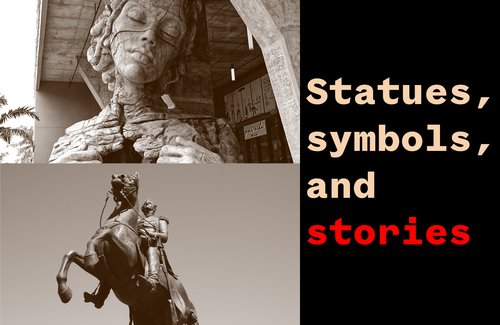
Look around your community. Who gets put on a pedestal (literally)? What kinds of statues are in your town/city/region? Whose names are on public buildings, such as schools, and who is featured in public art, such as murals?
Have any of these things changed, been renamed, removed in recent years? If so, let’s find out why.
For this assignment, think about how communities decide which historical perspectives and people to honor in statutes, murals/paintings, and public spaces.
Are these symbols important? How do they connect to the present day? Who gets lifted up and who gets left out– and why does that matter?
HOW TO SUBMIT
This prompt does not have an active deadline to submit to PBS NewsHour Student Reporting Labs. However, students are encouraged to publish their stories on their school/club/program website or through video/social platforms such as YouTube, Instagram or Twitter and tag Student Reporting Labs.
FACEBOOK: /STUDENTREPORTINGLABS
This project originated as part of PBS's Iconic America, a documentary series exploring America’s history through iconic national symbols, places, and archetypes.
It was adapted for the Global Education Toolkit, made possible with support from the Longview Foundation.
A set of moral principles based on standards of right and wrong, usually in terms of obligations, benefits to society, fairness, or specific virtues.
The condition of having or being composed of differing elements. Especially in the context of the inclusion of people of different races, cultures, etc. in a group or organization
The act or practice of including and accommodating people who have historically been excluded (as because of their race, gender, sexuality, or ability)
Local information and events are newsworthy because they affect the people in our community and region. We care more about things that happen “close to home.”
Awareness of the elements of environment through physical sensation or intuitive cognition. A capacity for comprehension and understanding.
People are attracted to information that helps them make good decisions. If you like music, you find musician interviews relevant. If you’re looking for a job, the business news is relevant. We need to depend on relevant information that helps us make decisions.
The term “empathy” is used to describe a wide range of experiences. A generally definition is the ability to sense other people’s emotions, coupled with the ability to imagine what someone else might be thinking or feeling. In media-making, creators can have empathy for their subjects and the audience can empathize with the characters.
Video stories about newsworthy issues and topics, factual information, balanced reporting, research, voice overs, soundbites, b-roll footage, infographics, reporter standup, nats (natural sound bites).
Narration and/or voiceover (VO), scene reconstructions, archival footage, nats (natural sound), b-roll, images, research, lengthy interviews, soundbites.
An investigation into and study of sources in order to establish facts and reach new conclusions.
The process of verifying the accuracy of a piece of information.
A desire to learn and know about something or anything.
The supplemental footage used to visually support your A-ROLL.
Search: broll.
Historical inquiry is based on materials left from the past that can be studied and analyzed. (NCSS D2.His.9.9-12 - D2.His.13.9-12)
Determine the kinds of sources that will be helpful in answering compelling and supporting questions, taking into consideration multiple points of view represented in the sources, the types of sources available, and the potential uses of the sources. (NCSS D1.5.9-12)
Students use digital tools to broaden their perspectives and enrich their learning by collaborating with others and working effectively in teams locally and globally. (ISTE)
Historical understanding requires recognizing this multiplicity of points of view in the past, which makes it important to seek out a range of sources on any historical question rather than simply use those that are easiest to find. It also requires recognizing that perspectives change over time, so that historical understanding requires developing a sense of empathy with people in the past whose perspectives might be very different from those of today. (NCSS D2.His.4.9-12 - D2.His.8.9-12)
In order to act responsibly and effectively, citizens must understand the important institutions of their society and the principles that these institutions are intended to reflect. That requires mastery of a body of knowledge about law, politics, and government. (NCSS D2.Civ.1.9-12 - D2.Civ.6.9-12)
Journalism
Representation
Stereotypes and Misconceptions
Race and Justice
Civics
History
Arts
Identity
Intermediate
Advanced
Post It Notes
White board, chalkboard or other visual board
Markers
Computers
Camera or Mobile Phone
Notebook
4-6 Weeks